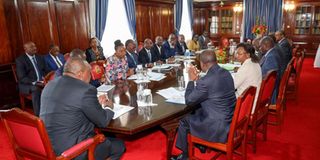Protection from Covid-19 rests on individual effort

What you need to know:
- NERC was formed on February 28, two weeks before the first Covid-19 case in the country.
- NERC was mandated with coordination of the country’s preparedness, prevention and response of the disease.
- So far, all counties have hospitals with Covid-19 capability and PPE for health workers.
- This has seen Kenya conduct more tests than its neighbours.
By the weekend, Covid-19 had killed about 420 Kenyans and sickened 26,000 others since the first case in March.
Yet the statistics would have been grimmer had the government not taken drastic measures combat the disease and cushion Kenyans against the debilitating effects of the coronavirus.
The National Emergency Response Committee (NERC) was formed on February 28, two weeks before the first Covid-19 case in the country and 12 days prior to the World Health Organisation declaration of the disease as a global pandemic.
NERC was mandated with coordination of the country’s preparedness, prevention and response of the disease, including sourcing for medical supplies, training of doctors and nurses and setting up of quarantine and isolation facilities.
So far, all counties have hospitals with Covid-19 capability and PPE for health workers. This has seen Kenya conduct more tests than its neighbours.
The County Government Coordination and Food Supply Committee averted a food security crisis by ensuring that agricultural production activities, market access and the food value chain are uninterrupted and the vulnerable have access to clean running water, which is a matter of life and death.
Most vulnerable
A National Economic and Business Response Working Group coordinates the financial resources for the pandemic response and maps out the macro and microeconomic impact of Covid-19. It reduced income tax from 30 per cent to 25 per cent, gave tax relief to those earning Sh24,000 or less per month and allocated Sh10 billion to the most vulnerable — the elderly, handicapped and orphans.
Value Added Tax was cut from 16 per cent to 14 per cent and Sh10 billion allocated to VAT refunds to business and Sh1 billion to the universal health coverage (UHC) to hire health workers. This was Sh216 billion reinjected into the economy, followed by a Sh53.7 billion economic stimulus package.
To provide employment opportunities to the youth, the Sh10 billion Kazi Mtaani initiative was launched, targeting 300,000 youth whose livelihoods have been negatively impacted by Covid-19.
In March, President Uhuru Kenyatta directed the National Treasury to set up the Covid-19 Fund to mobilise resources towards containing the spread, effects and impact of the pandemic. Led by Ms Jane Karuku, it has so far received over Sh2 billion in cash donations and supports the less vulnerable in society by giving cash stipends and foodstuff.
To strike a balance between safeguarding livelihoods and protecting lives, Kenya advocated a safe and phased reopening of the economy.
However successful the government’s efforts may be, winning the war or not will depend more on personal responsibility, with everyone protecting themselves and their loved ones from the virus.
Mr Mucheru is Kenya’s Cabinet Minister for ICT, Innovation and Youth Affairs.





